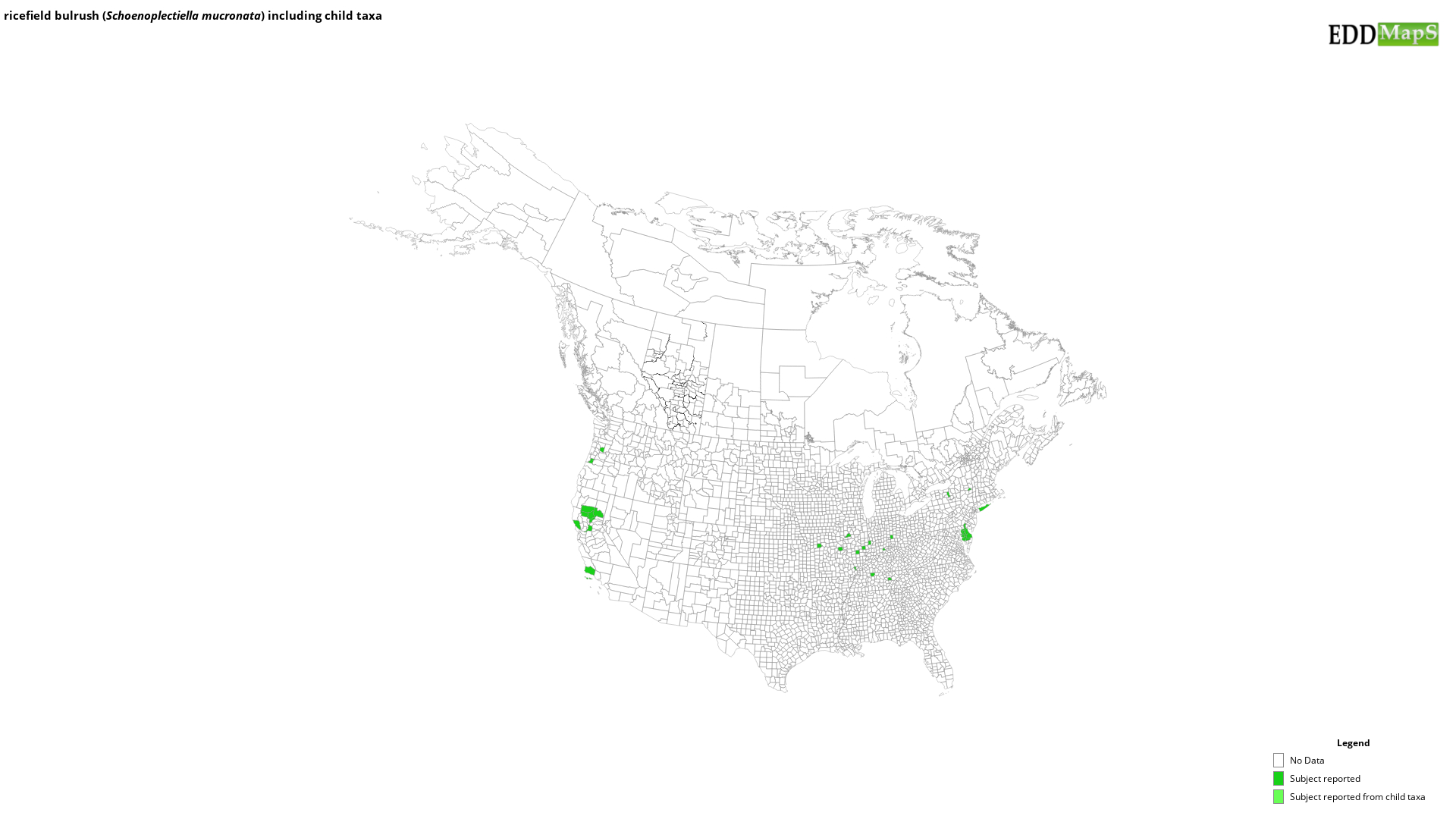ricefield bulrush
(Schoenoplectiella mucronata)
This species is Introduced in the United States
ORIGIN: Africa, Asia, Australia, Europe
GROWTH TRAITS: Annual (with fibrous roots) or perennial (with short, hard rhizomes) sedge that forms clumps 1-3’ (0.6-0.9 m) tall. True leaves are barely noticeable; they are reduced to small sheaths that encase the bottoms of stems. Stems are triangular in cross-section and may droop slightly. Clustered inflorescences of 4-25 cone-shaped spikelets occur just below stem tips. An angled, stiff bract extends from inflorescences and may resemble a continuation of the stem. Stems and bracts are bright green with smooth, straight margins. Flowers are green at first but mature to brown and bloom summer to fall. They are followed by small, bulb-shaped seeds ('nuts') that have tiny, thin bristles and mature to dark brown.
REPRODUCTION: Spreads by seed and rhizomes. Seeds may remain viable in the soil for many years.
HABITAT: ricefield bulrush is a weed of wet and boggy areas that can also grow in shallow water. It is found in disturbed and early successional wetlands and wetland restorations and along the margins of lakes and rivers. Plants grow best in full sun.
LOOK-ALIKES: The triangular stems, non-showy green flowers that mature to brown, and nut-like fruit are all characteristic of the sedge family and help differentiate ricefield bulrush and other sedges from similar, unrelated species. Within the family, the cone-like spikelets and bristled fruits help differentiate ricefield bulrush from other sedges. The native Hall's bulrush (Schoenoplectiella hallii), weakstalk bulrush (S. purshiana), and Smith's bulrush (S. smithii) all have shorter and more delicate stems that droop much more. The native common threesquare (Schoenoplectus pungens) has similar stems, but its inflorescences have much longer stamens, and the bract extending from the inflorescence is not angled as it is for ricefield bulrush.
CITATIONS:
Rawlins, K.A., R.L. Winston, C.T. Bargeron, D.J. Moorhead, and R. Carroll. 2018. New Invaders of the Northeast and Northcentral United States. USDA Forest Service, Forest Health Assessment and Applied Sciences Team, Morgantown, West Virginia. FHTET-2017-04. Retrieved from https://bugwoodcloud.org/resource/pdf/FHTET-2017-04_New%20Invaders_NE.pdf
GROWTH TRAITS: Annual (with fibrous roots) or perennial (with short, hard rhizomes) sedge that forms clumps 1-3’ (0.6-0.9 m) tall. True leaves are barely noticeable; they are reduced to small sheaths that encase the bottoms of stems. Stems are triangular in cross-section and may droop slightly. Clustered inflorescences of 4-25 cone-shaped spikelets occur just below stem tips. An angled, stiff bract extends from inflorescences and may resemble a continuation of the stem. Stems and bracts are bright green with smooth, straight margins. Flowers are green at first but mature to brown and bloom summer to fall. They are followed by small, bulb-shaped seeds ('nuts') that have tiny, thin bristles and mature to dark brown.
REPRODUCTION: Spreads by seed and rhizomes. Seeds may remain viable in the soil for many years.
HABITAT: ricefield bulrush is a weed of wet and boggy areas that can also grow in shallow water. It is found in disturbed and early successional wetlands and wetland restorations and along the margins of lakes and rivers. Plants grow best in full sun.
LOOK-ALIKES: The triangular stems, non-showy green flowers that mature to brown, and nut-like fruit are all characteristic of the sedge family and help differentiate ricefield bulrush and other sedges from similar, unrelated species. Within the family, the cone-like spikelets and bristled fruits help differentiate ricefield bulrush from other sedges. The native Hall's bulrush (Schoenoplectiella hallii), weakstalk bulrush (S. purshiana), and Smith's bulrush (S. smithii) all have shorter and more delicate stems that droop much more. The native common threesquare (Schoenoplectus pungens) has similar stems, but its inflorescences have much longer stamens, and the bract extending from the inflorescence is not angled as it is for ricefield bulrush.
CITATIONS:
Rawlins, K.A., R.L. Winston, C.T. Bargeron, D.J. Moorhead, and R. Carroll. 2018. New Invaders of the Northeast and Northcentral United States. USDA Forest Service, Forest Health Assessment and Applied Sciences Team, Morgantown, West Virginia. FHTET-2017-04. Retrieved from https://bugwoodcloud.org/resource/pdf/FHTET-2017-04_New%20Invaders_NE.pdf
Selected Images
Maps
EDDMapS Distribution - This map is incomplete and is based only on current site and county level reports made by experts, herbaria, and literature. For more information, visit www.eddmaps.org
State Lists - This map identifies those states that have this species on their invasive species list or law.
Invasive Listing Sources
- Jil Swearingen, personal communication, 2009-2017
- Maryland Invasive Species Council - Invasive Species of Concern in Maryland
- National Park Service, Mid-Atlantic Exotic Plant Management Team Invasive Plant List
- National Park Service, National Capital Region Exotic Plant Management Team Invasive Plant List
- New Invaders of the Northeast and Northcentral
- Nonnative Invasive Species in Southern Forest and Grassland Ecosystems
- Plant Invaders of Mid-Atlantic Natural Areas
- Washington Noxious Weeds
Taxonomic Rank
| Domain: Eukarya |
| Kingdom: Plantae |
| Phylum: Magnoliophyta |
| Class: Magnoliopsida |
| Superorder: Lilianae |
| Order: Poales |
| Family: Cyperaceae |
| Subfamily: Cyperoideae |
| Tribe: Fuireneae |
| Genus: Schoenoplectiella |
| Schoenoplectiella mucronata |
References
Common Name Reference: The Plant List (2010). Version 1. Published on the Internet; http://www.theplantlist.org/ (accessed 1st January).
Scientific Name Reference: The Plant List (2010). Version 1. Published on the Internet; http://www.theplantlist.org/ (accessed 1st January).


